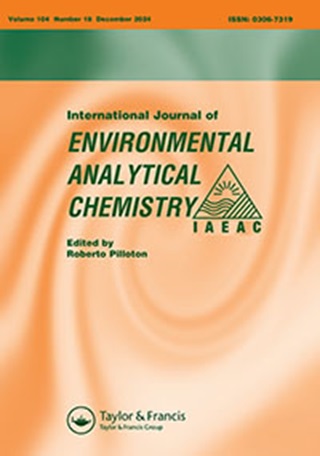粉末活性炭和磁石粘土复合材料吸附水中Cd +的实验设计、动力学、平衡和热力学研究
IF 2.5
4区 化学
Q3 CHEMISTRY, ANALYTICAL
International Journal of Environmental Analytical Chemistry
Pub Date : 2023-10-23
DOI:10.1080/03067319.2023.2267450
引用次数: 0
摘要
摘要垃圾填埋场中的镉和其他重金属在与水或湿气接触时可能会浸出到土壤和地下水中,从而对健康和环境造成重大风险。在这项研究中,我们合成了两种复合材料,复合材料I (C(I))和复合材料II (C(II)),使用阿尔及利亚粘土和椰子壳衍生的活性炭。这些复合材料用于控制垃圾填埋场废物管理。这些组分以不同的质量百分比混合,有效地吸附水溶液中的镉(Cd2+)。我们采用实验设计进行了参数吸附研究。复合C(II)对Cd2+的去除效果更好,Qmax可达163 mg。在25°C时,R提高了59%,而C(I)的Qmax为131 mg。g−1和47%的R。pH研究表明,在pH范围内有显著的吸附作用[6-8]。实验采用筛选设计优化Cd2+吸附,建立响应面。X1、X4和X6的最佳值分别为6、180振荡/min和185 mg。分别L−1。关键词:重金属去除土壤修复环境污染物可持续材料筛选设计AIT HAMOUDI进行了实验,讨论了结果,并准备了手稿。L.NOURI和S.HEMIDOUCHE讨论了实验结果并准备了实验设计。N.KHELIFA讨论了结果。A.khelifi, a.boudjemaa, k.bachari。资助和监督并批改稿件。所有作者都阅读并批准了最终的手稿。披露声明作者未报告潜在的利益冲突。本文的补充数据可以在线访问https://doi.org/10.1080/03067319.2023.2267450。本文章由计算机程序翻译,如有差异,请以英文原文为准。
Adsorption of Cd 2+ from aqueous solution onto composites based on powdered activated carbon and Maghnia clay adsorbents: experimental design, kinetic, equilibrium and thermodynamic study
ABSTRACTCadmium and other heavy metals in landfills pose significant health and environmental risks due to their leaching potential into soil and groundwater when in contact with water or moisture. In this study, we synthesised two composites, composite I (C(I)) and composite II (C(II)), using Algerian clay and coconut shell-derived activated carbon. These composites are intended for controlled landfill waste management. The components are mixed at varying mass percentages, effectively adsorbing cadmium (Cd2+) from aqueous solutions. We conducted a parametric adsorption study using an experimental design. Cd2+ removal is more effective with composite C(II), reaching a Qmax of 163 mg.g−1 and an improved R of 59% at 25°C, while C(I) achieves a Qmax of 131 mg.g−1 and an R of 47%. The pH study indicated significant adsorption in the pH range [6–8]. The experiment utilised a screening design to optimise Cd2+ adsorption and establish the response surface. The coded variable Xi ranged from −1 (low) to + 1 (high) such as pH (X1: 2–6), temperature (X2: 25–45°C), composite mass (X3: 0.5–2.5 g.L−1), stirring speed (X4: 20–180 Oscillation/min), equilibrium time (X5: 60–120 min), and initial solution concentration (X6: 25–225 mg.L−1). The optimal values for X1, X4, and X6 were found to be 6, 180 Oscillation/min, and 185 mg.L−1, respectively.KEYWORDS: Heavy metal removalsoil remediationenvironmental contaminantssustainable materialsscreening design Author contributionS.AIT HAMOUDI performed the experiment, discussed the results, and prepared the manuscript. L.NOURI and S.HEMIDOUCHE discussed the results and prepared the experimental design. N.KHELIFA discussed the results. A.KHELIFI, A.BOUDJEMAA, K.BACHARI. Funding and supervision and corrected the manuscript. All authors read and approved the final manuscript.Disclosure statementNo potential conflict of interest was reported by the author(s).Supplementary dataSupplemental data for this article can be accessed online at https://doi.org/10.1080/03067319.2023.2267450.
求助全文
通过发布文献求助,成功后即可免费获取论文全文。
去求助
来源期刊
CiteScore
5.90
自引率
7.70%
发文量
373
审稿时长
4.4 months
期刊介绍:
International Journal of Environmental Analytical Chemistry comprises original research on all aspects of analytical work related to environmental problems. This includes analysis of organic, inorganic and radioactive pollutants in air, water, sediments and biota; and determination of harmful substances, including analytical methods for the investigation of chemical or metabolic breakdown patterns in the environment and in biological samples.
The journal also covers the development of new analytical methods or improvement of existing ones useful for the control and investigation of pollutants or trace amounts of naturally occurring active chemicals in all environmental compartments. Development, modification and automation of instruments and techniques with potential in environment sciences are also part of the journal.
Case studies are also considered, particularly for areas where information is scarce or lacking, providing that reported data is significant and representative, either spatially or temporally, and quality assured. Owing to the interdisciplinary nature of this journal, it will also include topics of interest to researchers in the fields of medical science (health sciences), toxicology, forensic sciences, oceanography, food sciences, biological sciences and other fields that, in one way or another, contribute to the knowledge of our environment and have to make use of analytical chemistry for this purpose.

 求助内容:
求助内容: 应助结果提醒方式:
应助结果提醒方式:


